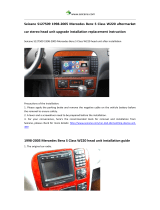
18
Aquaplaning
Depending on the depth of the water
layer on the road, aquaplaning may
occur, even at low speeds and with new
tires. Reduce vehicle speed, avoid track
grooves in the road and apply brakes
cautiously in the rain.
Tire Traction
The safe speed on a wet, snow covered
or icy road is always lower than on a
dry road.
You should pay particular attention to
the condition of the road whenever the
outside temperatures are close to the
freezing point.
Warning!
If ice has formed on the road, tire
traction will be substantially
reduced. Under such weather
conditions, drive, steer and brake
with extreme caution.
We recommend M + S radial-ply tires
for the winter season for all four wheels
to insure normal balanced handling
characteristics.
On packed snow, they can reduce
your stopping distance as com-pared
with summer tires. Stopping distance,
however, is still considerably greater
than when the road is wet or dry.
Tire Speed Rating
Your vehicle is factory equipped with an
"H"-rated tire, which has a speed rating
of 130 mph (210 km/h). An electronic
speed limiter prevents your vehicle from
exceeding the speed resting.
Notwithstanding tire speed rating, local
speed limits should be obeyed, and
prudent driving speeds appropriate to
prevailing conditions should be
employed.
Warning!
Never operate a vehicle at speeds
greater than the maximum speed
rating of the tires with which it is
equipped. Exceeding the maximum
speed for which tires are rated can
lead to sudden tire failure, causing
loss of vehicle control, and
resulting in personal injury and
possible death.
Parking
Warning!
To reduce the risk of personal injury
as a result of vehicle movement,
before turning off the engine and
leaving the vehicle always:
1. Keep right foot on brake
pedal.
2. Firmly depress parking brake
pedal.
3. Move the selector lever to
position "P".
4. Slowly release brake pedal.
5. Turn front wheels towards
the road curb.
6. Turn the key to steering
lock position 0 and remove.
Important!
It is advisable to set the parking brake
whenever parking or leaving the
vehicle. In addition, move selector
lever to position "P".
When parking on hills, always set the
parking brake.





















